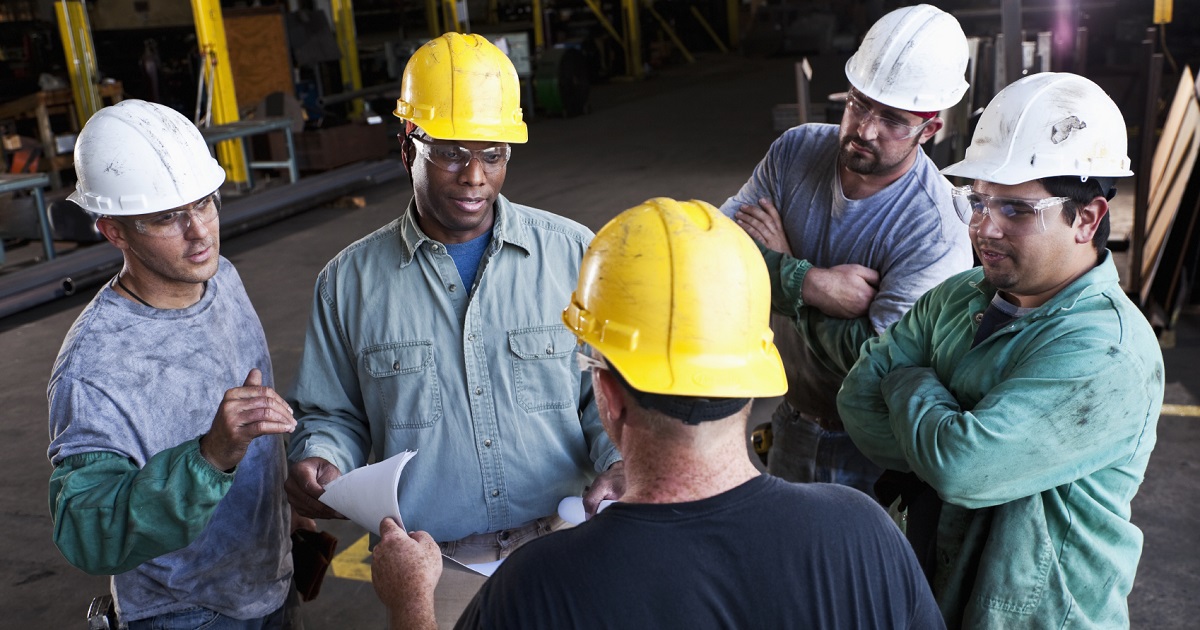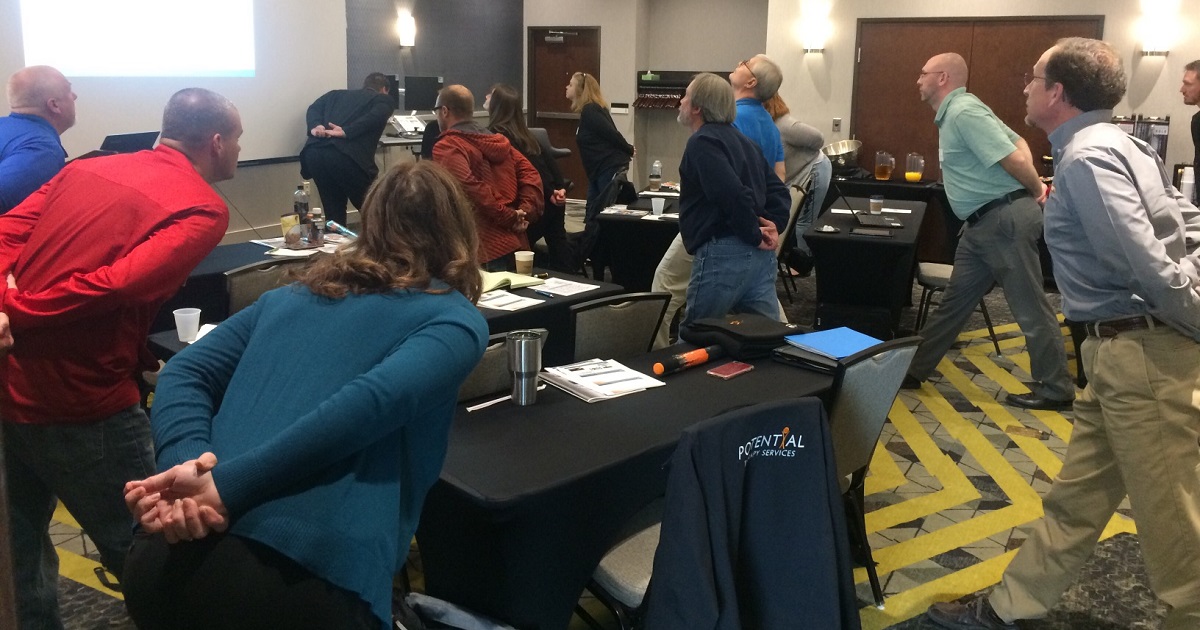For Media Inquiries
Contact Revee White, Director of Marketing and Communications at rwhite1@mem-ins.com or 573.499.4190.
Do you remember your very first day on a new job? It was probably a blur of excitement and paperwork – and safety information! Many employees attend safety meetings during their first week on the job. But sometimes, it’s the first and last time they hear about safety. Over time, employees can forget the safety rules that keep your workplace – and your employees – safe.
Safety meetings can keep your employees fresh on the safety know-how they need. It is also a great chance for them to ask questions or share concerns.
On this episode of the WorkSAFE Podcast, we sit down with Technical Services and Training Specialist Flint Walton. Walton is a Missouri Employers Mutual employee. He has also worked in the insurance industry for over 30 years. He provides employers with essential safety information and training.
First, we’ll cover what a safety meeting is. Then we’ll recommend how often you should have them with your employees. Finally, we’ll share some great safety meeting topics. Stay tuned until the end for some tips on how to keep your safety meetings interesting.
Listen to this interview on the WorkSAFE Podcast, or read the show notes below.
What is a safety meeting?
“A safety meeting is a session to remind employees of the safety practices that they’ve already learned. So, in other words, onboarding that they’ve gone through, new hire training and orientation,” Walton said.
Safety meetings are a chance to introduce employees to new information. There may be new techniques they don’t know about. Your workplace may have bought new equipment they haven’t used yet. Safety regulations may have changed since they were first hired. Holding a safety meeting is a chance for them to catch up. “They are also important in building a strong safety culture,” Walton added, “And reinforcing management’s commitment to safety.”

When a new hire joins the workplace, orientation can happen quickly. There is a lot for new employees to remember. They might get a quick walk around the shop floor and a few handshakes with their team. The next stop is usually paperwork with Human Resources – they may even get a uniform. After a speedy chat on where to find a pair of safety goggles and how to use their machine, it’s time to get to work.
This quick introduction to safety happens in companies across every industry. Employees may remember a few things, like vacation time and where the bathroom is. However, they don’t remember every detail. And unfortunately, new hires are often the first to get hurt. Some employees don’t even get safety training. Their managers don’t have the time. Safety training, or the lack of it, sends a message to the employee. It lets them know how much their employer cares about their safety on the job.
What kind of business should hold a safety meeting?
Businesses in every industry should hold safety meetings. There are safety risks in every workplace. Large businesses sometimes have one employee who focuses on safety. When your business has fewer employees, safety meetings might look different. They may just be a short opportunity to catch up on the safety risks of the day.
Businesses in every industry should hold safety meetings. Tweet this. >
How long should a safety meeting be?
The length of a safety meeting will depend on the topic. Some safety meetings are short. Reviewing something like a seat belt policy only takes a few minutes. On the other hand, some safety topics, like lockout/tagout procedures, take longer. You may need more time to share instructions or show examples.
When should I have a safety meeting?
You can have a safety meeting whenever you need to. Make sure your employees sign off on your safety policies at least once a year. You can cover a new safety topic once a month. Hold safety meetings at a regular time and place. If your employees work away from the business, then having a regular meeting can help them schedule their time. Quick safety meetings can also be held on job sites. Meet with employees before you start working. Share more about the job and answer any questions they might have.
Some employers think they don’t need to have a safety meeting. Sometimes, they have never had an injury happen on the job. Others think they don’t have any safety risks. As a result, their employees don’t get regular information on how to stay safe.
Topics for safety meetings
Walton says there are three categories of safety information you should share with your employees. The first is information that is the most important to keep employees safe. For example, these topics include:
- Regulatory compliance (hazard communication, how to use fire extinguishers, etc.)
- Fire and emergency action plans
- How to use personal protective equipment (PPE)
- First aid and CPR training
The second category is safety topics for your industry. Take a look at the common injuries. For example, what injuries happen the most? How can you prevent them? Many injuries can be prevented simply by sharing information. These topics include:
- Seat belt usage
- Distracted driving
- Slips, trips, and falls
- Tie-off systems
- Ladder usage
- Mounting and dismounting equipment
The third category is safety practices your employees might forget about. Do your employees know the best way to lift heavy boxes? Are they stopping to stretch after doing repetitive tasks? Are they watching out for others on the job? Remind them by covering these topics:
- How to lift/carry
- Situational awareness
- Overexertion (heavy lifting, repetitive tasks, etc.)
- Ergonomics
Safety meetings: an opportunity to improve
Safety meetings have a lot of benefits. Employees can ask questions. They can also talk about their concerns. Safety meetings help keep people from getting injured. However, incidents happen.
If you have an incident on the job, make sure to do an incident investigation. This will help you understand why the incident happened. Did someone break the safety rules? Does old equipment need to be replaced? When you find out the cause, then you can share it with employees in a safety meeting. Talk about why the incident happened. If you need more safety rules, then share them in the meeting.
Lowering your premiums with safety meetings
Many employers don’t know that safety meetings can lower their premium. Most have an experience modification factor, or e-mod. This calculation uses past losses to predict your future loss. The average e-mod is 1.0. If you have an incident on the job, then your e-mod will increase. As a result, your premium will cost more.
Without regular safety meetings, you could miss seeing important safety risks. Has the same incident happened more than once in your business? Have you ever talked to employees about it? Are new employees aware of your safety procedures? If you don’t talk regularly with your employees, then the same incidents could happen over and over again. Each time, your e-mod will get higher.
It takes time to change your e-mod. Holding safety meetings often is a great way to lower it. Eventually, you could pay less premium.
6 tips to make your safety meeting more engaging
Safety meetings, just like other meetings, can run long. Employees may show up tired after a long shift. During the meeting, some may be tempted to focus on their smartphones. How do you keep your employees’ attention?
Walton has a few tips for making safety interesting for your teams.
- Avoid day-long sessions. If you can, avoid making safety sessions last all day. Cover the information you need to. Then get back to work.
- Don’t rely on a presentation. Try to avoid reading off of slides. Ask your employees questions. See what they know, and go from there.
- Get their feedback. Employees are often first to know when something on the job isn’t quite right. Do they have questions for you? Suggestions? Use the time in your safety meeting to find out.
- Rely on trusted workers. Do you have an employee that has been on the job for years? Ask them to share their experiences. Hearing from an older co-worker can often help younger employees.
- Show people doing things right. Employees appreciate being recognized. Walk around your business. Look for employees following safety rules. Use them as examples in your safety meeting.
- Invite management. Managers or supervisors should come to safety meetings. Have them sit in on safety meetings. They can even lead a meeting. This shows employees that the whole company values safety, including their leaders.
Building a safety culture in your business is important. Walton says how safe your employees feel at work matters. Every night, employees go home. They talk to their families about work. If they feel safe on the job, their families will encourage them to stay there. But if they don’t feel safe, their families might encourage them to find a different job – one where they know they can be safe.
Holding your first safety meeting
So what are the first three things you need to hold your first safety meeting? Walton identified three things:
- Management support. Their support will help you find the time and resources to hold your safety meetings.
- Set a regular time. This will help build a safety culture. Employees will also learn when and where they need to be each week or month.
- Cover the most important topics first. Focus on topics that cover incidents that have already happened, or areas where there are a lot of safety risks.
Safety meetings are important not just for your business, or your bottom line. They are also important for your employees. “Even if the meeting’s not perfect,” Walton said, “They’re going to know that you care.”
Check out more episodes of the WorkSAFE podcast, or visit our Resource Library for free safety policies, safety meeting topics, and more.
